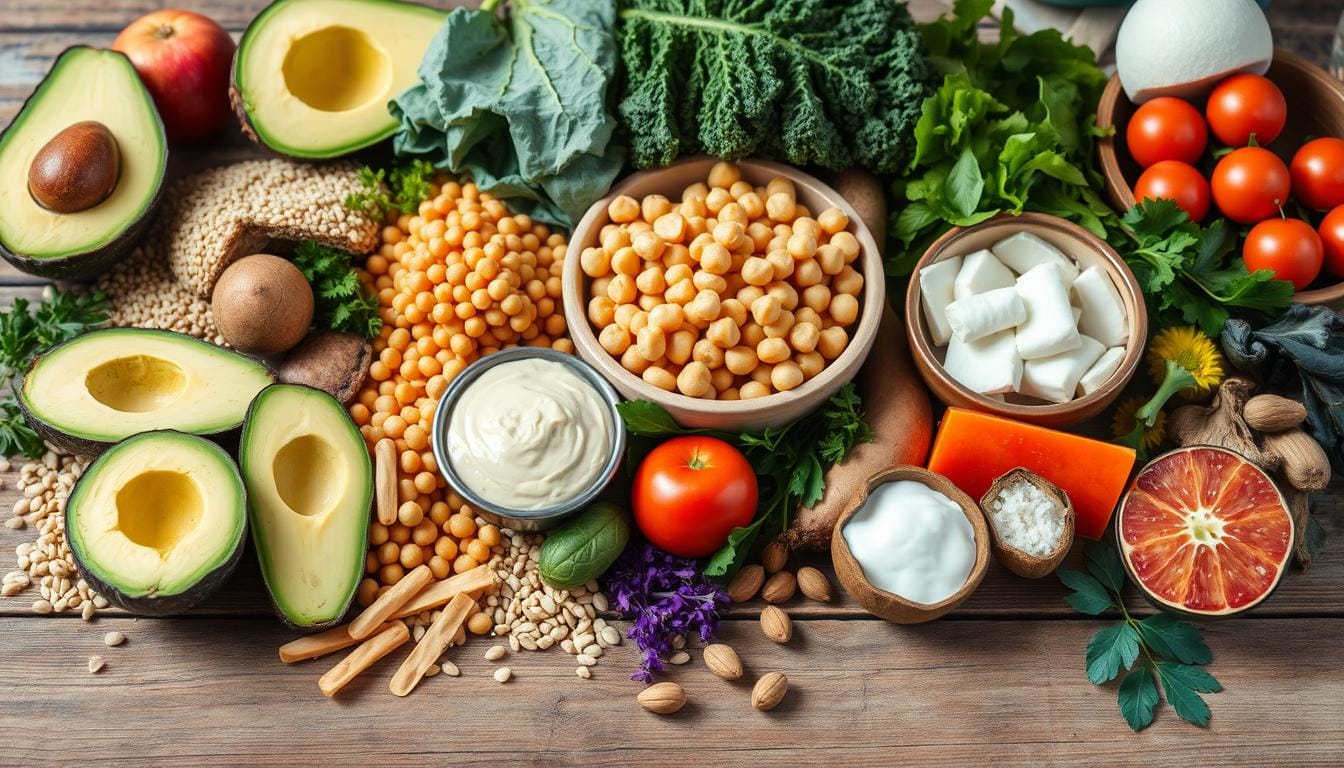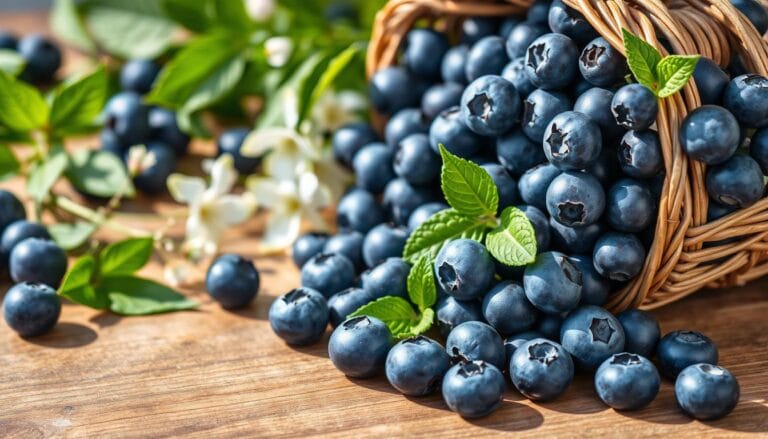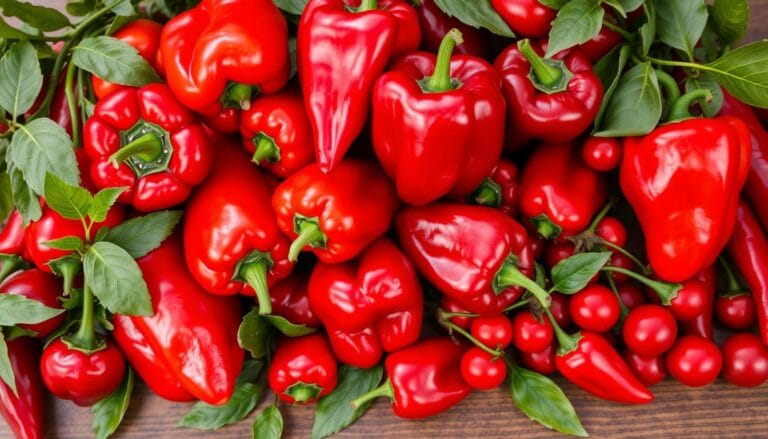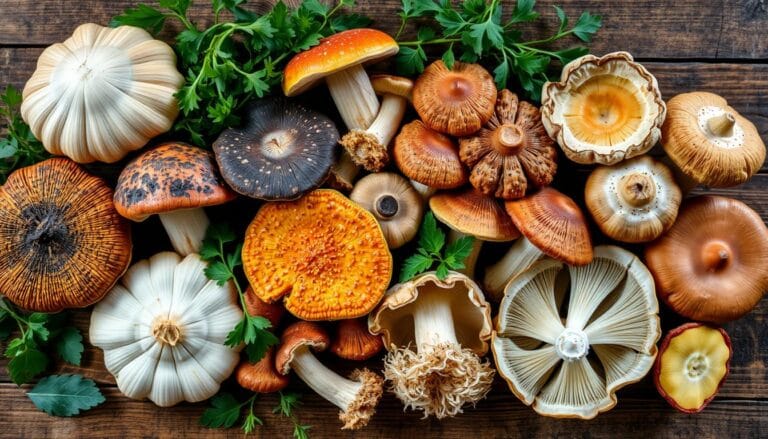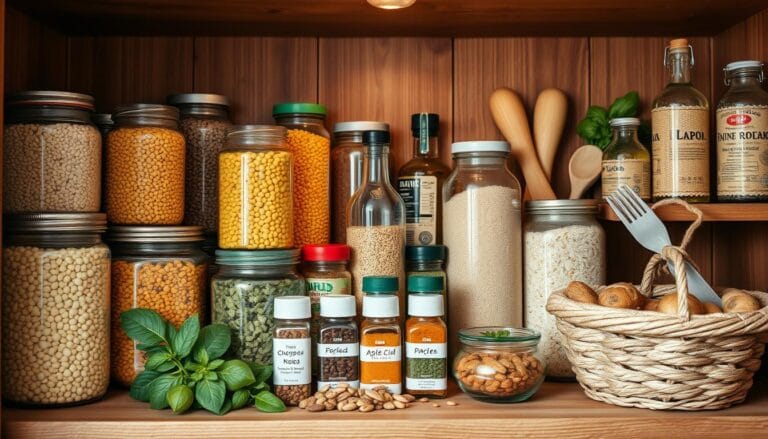15 hippie food ingredients you need to be cooking with
Remember when your grandmother’s kitchen was full of natural ingredients? Those days are back. This 15 hippie food ingredients are changing how we cook today. Now, we focus on organic vegetables and whole foods that make us feel good.
The 1960s counterculture movement changed how we see food. People are now going back to farmers markets and growing their own food. This way, we connect with the earth’s gifts.
Cooking with these ingredients is more than just eating well. It’s a choice for a sustainable, healthy life. Whether you’re a pro chef or just starting, these 15 ingredients will make your kitchen a place of wellness.
Table of Contents
Understanding the Rise of Hippie Food Culture
The roots of modern health food culture go back to the 1960s and early 1970s. This time was a big change in how Americans saw food, health, and wellness.
The Origins of Modern Health Food Movement
Between 1965 and 1974, baby boomers started questioning traditional food systems. The counterculture movement focused on:
- Organic agriculture revival
- Community-based food networks
- Sustainable nutrition practices
Why Natural Ingredients Matter Today
The move to superfood grains and plant-based proteins was more than a trend. It was a response to growing health problems. Today, diet-related issues are major causes of disease in the U.S., showing the need for careful eating.
“Our food choices are a revolutionary act of personal and planetary health.” – Unknown Wellness Advocate
From Counter-Culture to Mainstream Kitchen
What started as a radical nutrition approach is now common. People are looking for plant-based proteins and superfood grains. This has changed how we think about healthy eating.
| Food Culture Era | Key Characteristics |
|---|---|
| 1960s Counterculture | Experimental, community-driven nutrition |
| Modern Health Movement | Scientific, wellness-focused eating |
The journey from a fringe movement to a global philosophy shows the lasting effect of early nutrition pioneers.
Essential Herbs and Healing Spices for Your Pantry
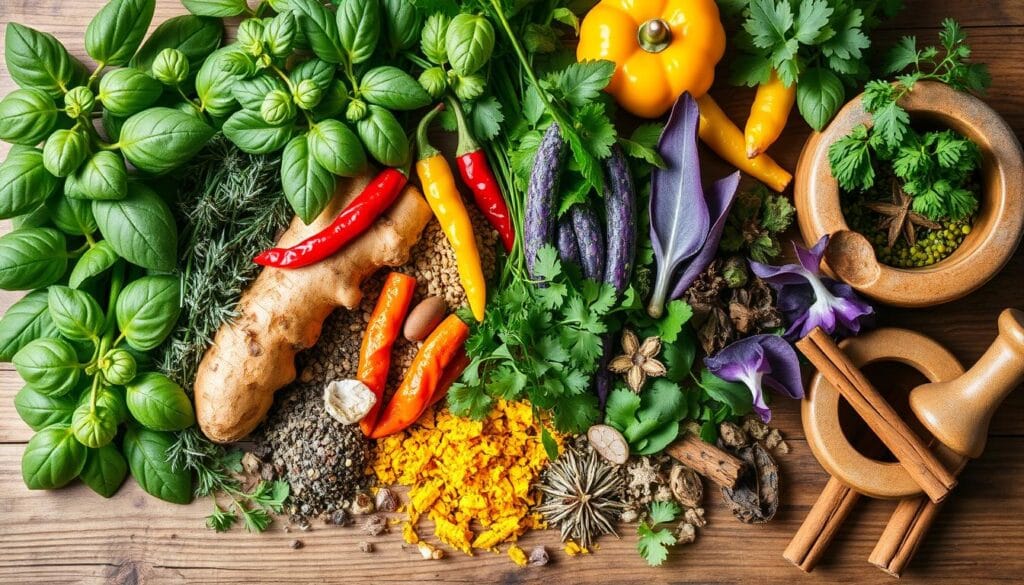
Your kitchen can become a healing center with the right herbs and spices. These natural ingredients add flavor and are packed with nutrients. They can change your cooking and help your health.
Oregano is a standout healing herb with amazing properties. It’s full of vitamins and minerals like:
- Vitamin A
- Vitamin C
- Vitamin E
- Zinc
- Magnesium
- Iron
Research shows oregano’s health benefits. It fights bacteria and fungi, making it a natural medicine star. Oregano oil can fight off Salmonella and E. coli, boosting your immune system.
“Food is thy medicine” – Ancient Hippie Wisdom
Using healing herbs and spices in vegetable broths boosts flavor and nutrition. Fresh herbs are best, so grow a small garden on your windowsill.
Here are ways to use oregano and other healing herbs:
- Adding to vegetable broths
- Creating herbal tea infusions
- Using as a topical treatment for minor skin conditions
- Incorporating into daily cooking
Pro tip: Take oregano oil daily during cold and flu season to boost your immune system naturally.
Healthy Hippie Ingredients Everyone Should Cook With
Turning your kitchen into a health hub begins with the right ingredients. Healthy hippie foods are more than a trend. They’re a way of life that focuses on whole, natural foods with amazing benefits.
Plant-Based Protein Powerhouses
Your body needs protein, and plant-based foods are a great source. The CDC says about 16% of your daily calories should be protein. Here are some top picks:
- Tempeh: A fermented soybean protein with a rich, nutty taste
- Chickpeas: Give you about 8 grams of protein per half-cup
- Raw nuts and seeds: Great for protein and packed with nutrients
- Lentils: Quick to cook and full of protein
Essential Superfood Components
Superfoods make your meals special. Add these nutrient-rich foods to your diet:
- Chia seeds: Full of omega-3s and super versatile
- Spirulina: A blue-green algae with all the protein you need
- Acai berries: Loaded with antioxidants and taste great
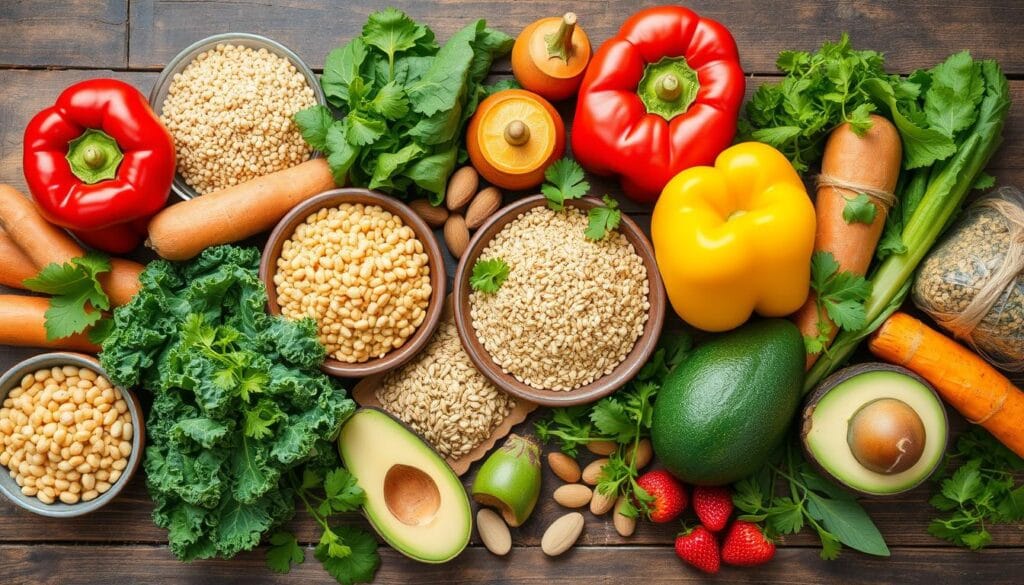
Natural Flavor Enhancers
Use these natural flavor boosters to add depth without artificial stuff:
- Nutritional yeast: A complete protein with all nine essential amino acids
- Miso paste: A fermented seasoning with probiotic benefits
- Fresh herbs: Add natural flavor to any dish
“Let food be thy medicine and medicine be thy food.” – Hippie Food Philosophy
By using these healthy hippie ingredients, you’ll make your meals into nutritional powerhouses. They’ll help support your overall health and wellness.
Sprouted Seeds and Microgreens Revolution
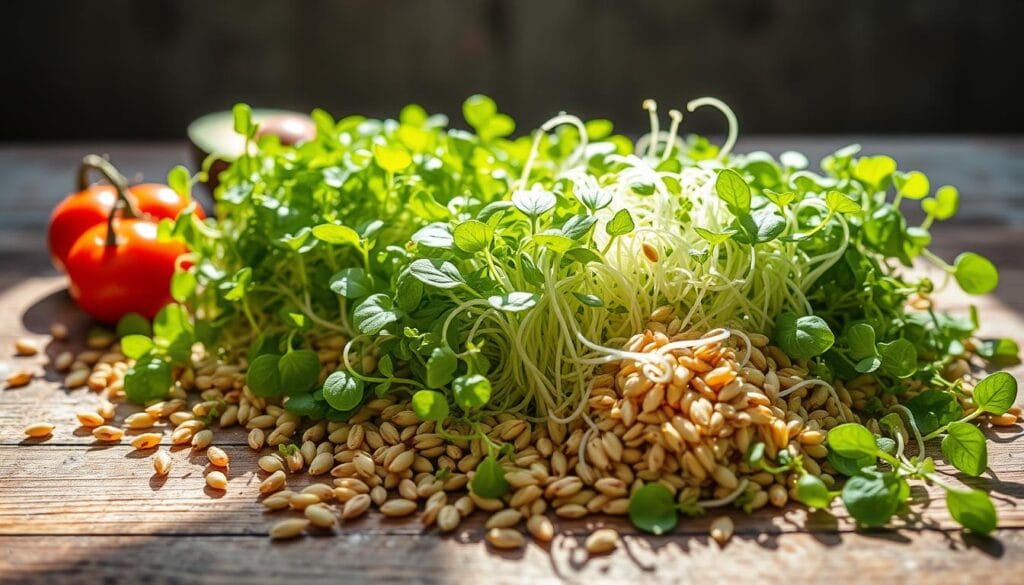
The world of organic vegetables and raw nuts and seeds is changing fast. Sprouting and microgreens are leading this change. These tiny foods pack a big punch of nutrition, adding intense flavors and nutrients to your meals.
Sprouting turns raw nuts and seeds into living foods full of nutrients. When seeds start to grow, they release enzymes and boost their nutrient levels. This makes the nutrients easier for your body to use.
“Microgreens are nutrition superstars – they contain up to 40 times more nutrients than mature plants!” – Dr. Gene Lester, USDA Agricultural Research Service
- Alfalfa sprouts: Excellent source of vitamins K and C
- Broccoli microgreens: Rich in sulforaphane, a powerful antioxidant
- Sunflower sprouts: High in protein and essential amino acids
- Radish microgreens: Supports digestive health
Growing your own organic vegetables and sprouts is simple. You can do it with just a little equipment. Turn raw nuts and seeds into nutritious ingredients right in your kitchen.
| Sprout Type | Nutrition Highlights | Growing Time |
|---|---|---|
| Mung Bean Sprouts | High in protein, low in calories | 3-5 days |
| Quinoa Sprouts | Complete protein, rich in minerals | 1-2 days |
| Lentil Sprouts | Excellent iron and folate source | 2-3 days |
Start your sprouting journey today. Discover a new world of nutrition and flavor in your meals!
Ancient Grains and Their Modern Applications
Rediscover the nutritional powerhouses of ancient grains that are transforming modern kitchens. These superfood grains have been cultivated for thousands of years. They offer exceptional health benefits and unique flavors that go beyond traditional wheat and rice.
Ancient grains are more than just a culinary trend. They represent a connection to traditional food cultures. They also provide remarkable nutritional profiles that support overall wellness.
Traditional Preparation Methods
Preparing ancient grains requires understanding their unique characteristics. Unlike modern processed grains, these heritage varieties often need special cooking techniques:
- Soaking quinoa to remove natural saponins
- Toasting amaranth to enhance its nutty flavor
- Slow-cooking teff for optimal texture
Nutritional Benefits of Heritage Grains
Each ancient grain brings distinctive nutritional advantages to your diet. Explore their remarkable health properties:
| Ancient Grain | Key Nutrients | Health Benefits |
|---|---|---|
| Quinoa | Complete Protein | Supports muscle development |
| Amaranth | Iron, Magnesium | Boosts cardiovascular health |
| Teff | Calcium, Fiber | Promotes digestive wellness |
Recipe Adaptations for Modern Kitchens
Transform these superfood grains into delicious, contemporary dishes that fit your busy lifestyle. From grain bowls to baked goods, ancient grains offer versatility and nutrition in every bite.
“Ancient grains are not just food, they’re a culinary time machine connecting us to our nutritional roots.” – Wellness Chef
Experiment with these remarkable grains and unlock a world of flavor, nutrition, and culinary creativity in your kitchen.
The Power of Fermented Foods and Probiotics
Explore the world of fermented foods, a key part of healthy hippie cooking. These foods are not just tasty; they’re full of probiotics that boost your digestive health.
“Fermentation is nature’s way of preserving food and boosting its nutritional value.” – Traditional Hippie Wisdom
Probiotics are becoming more popular in health circles. Studies reveal that 1 in 5 Americans now add these beneficial microbes to their diet. Fermented foods are a tasty, natural way to support your gut.
- Kombucha: A tangy, fizzy drink loaded with beneficial bacteria
- Kefir: A probiotic-rich yogurt drink
- Sauerkraut: Fermented cabbage with intense nutritional benefits
- Kimchi: A spicy Korean fermented vegetable dish
Fermented foods are incredibly versatile. You can easily add them to your daily meals, making them healthier and more flavorful.
| Fermented Food | Probiotic Benefit | Serving Suggestion |
|---|---|---|
| Kombucha | Digestive Health | Drink as a morning beverage |
| Kefir | Immune System Support | Add to smoothies |
| Sauerkraut | Gut Microbiome Balance | Side dish with meals |
Did you know that 70% of probiotics come from organic fermented foods? Choosing fermented foods means you’re feeding your body with ancient, healing ingredients.
Natural Sweeteners and Sugar Alternatives
Exploring natural sweeteners is key for healthy cooking. People are looking for better sugar options. Coconut products are leading this change in the kitchen.
The market for natural sweeteners is growing fast. Here are some interesting facts:
- Market growth expected at 5.8% CAGR from 2022 to 2028
- 74% of consumers actively reducing sugar intake
- Natural sweetener sales anticipated to reach $3.1 billion by 2024
Coconut products offer amazing sugar alternatives. Coconut sugar is a low-glycemic option with minerals and a caramel taste. Other great options include:
- Raw honey
- Maple syrup
- Stevia
- Coconut nectar
“Nature provides the sweetest solutions for our culinary needs” – Modern Hippie Cooking Wisdom
Stevia is the top choice for 50% of consumers. This shows a big move towards healthier options. About 67% of people are ready to pay more for natural sweetener foods.
Make your kitchen a place of healthy creativity. Try coconut products and natural sweeteners. They can change your cooking and support your health.
Root Vegetables and Earth’s Medicine
Root vegetables are like hidden treasures underground. They offer a direct link to the earth’s healing wisdom. This makes them a key part of holistic wellness through what we eat.
Exploring root vegetables opens up a world of health benefits. They can change how we cook and feed our bodies.
Seasonal Root Selection Guide
Choosing the right roots depends on the season and what you want to achieve. Here are some top picks for their nutritional value:
- Winter: Hearty carrots, parsnips, and rutabagas
- Spring: Fresh radishes and young beets
- Fall: Sweet potatoes and Jerusalem artichokes
Healing Properties and Uses
Root vegetables are full of healing powers. Each one has its own special benefits:
| Root Vegetable | Key Health Benefit |
|---|---|
| Turmeric | Powerful anti-inflammatory properties |
| Ginger | Boosts immune system |
| Burdock | Supports liver detoxification |
Storage and Preparation Tips
To get the most from your root vegetables, follow these tips:
- Store in cool, dark places
- Use vegetable broths to enhance flavor
- Roast, steam, or blend for versatile meals
“Let food be thy medicine and medicine be thy food” – Hippocrates
Pro tip: Add these roots to your daily meals. They can unlock their full nutritional power and support your wellness journey.
Conclusion
Your journey into healthy hippie ingredients is just starting. Plant-based proteins and whole foods are more than a trend. They’re a way to connect with nature’s gifts.
Using these ingredients in your cooking does more than boost your health. It joins a movement for sustainable eating and caring for the earth. Every meal is a chance to feed your body and help the planet.
The world of hippie food is full of new things to try. Begin by adding one or two new items to your recipes each week. You might find sprouted seeds, ancient grains, or new plant-based proteins. These can bring exciting tastes and health benefits to your cooking.
Your kitchen is a place for change. Choosing these healthy, earth-friendly foods is a big step. It’s not about being perfect. It’s about moving forward, connecting, and eating with care.
FAQ
What exactly are hippie food ingredients?
Hippie food ingredients are all about natural, whole foods. They focus on organic, plant-based, and nutrient-rich options. Think superfood grains, plant-based proteins, and raw nuts and seeds. Also, fermented foods, healing herbs, and spices, and ingredients that are minimally processed. These support health and sustainable living.
Are hippie food ingredients expensive to buy?
Some specialty items might cost more, but many hippie food staples are affordable. Legumes, beans, seasonal veggies, and bulk grains are cheap. Buying in bulk, shopping at local markets, and growing your own herbs can cut costs.
How can I start incorporating hippie food ingredients into my diet?
Start by adding plant-based proteins like tempeh and tofu to your meals. Try ancient grains like quinoa. Add fermented foods like kimchi to your dishes. Use healing herbs and spices to boost flavor and nutrition.
Are hippie food ingredients suitable for all dietary restrictions?
Yes, most hippie food ingredients are naturally gluten-free, vegan, and fit various diets. Options like coconut products, ancient grains, and plant-based proteins are versatile for different needs.
Do I need special cooking skills to prepare hippie food ingredients?
No, you don’t need special skills! Many ingredients are easy to prepare. Raw nuts and seeds are ready to eat, fermented foods are ready to go, and grains like quinoa are simple to cook. Start with simple recipes and grow your skills.
What are the main health benefits of hippie food ingredients?
These ingredients offer many health benefits. They improve digestion, boost nutrition, increase energy, enhance immune function, and reduce inflammation. Superfood grains, fermented foods, and healing herbs are packed with nutrients for wellness.
Can I grow some of these hippie food ingredients at home?
Yes, you can! Herbs, microgreens, and some veggies are easy to grow at home. Sprouting seeds and growing small herb gardens on windowsills are great ways to get fresh, organic ingredients. It also connects you to your food source.
How long can I store hippie food ingredients?
Storage times vary by ingredient. Dried grains and nuts can last months in airtight containers. Fermented foods last weeks in the fridge. Fresh herbs and veggies have shorter lives. Always check the storage guidelines for each ingredient.
Source Links
- https://modernhippiekitchen.com/ – Modern Hippie Kitchen
- https://modernhippiehabits.com/index.php/2024/07/15/whole-grain-mustard/ – Whole Grain Mustard | Staples from Scratch | Habits of a Modern Hippie
- https://homestylealchemy.com/2024/03/04/vintage-recipe-sunshine-happy-hippie-granola/ – Vintage Recipe: Sunshine Happy Hippie Granola – Homestyle Alchemy
- https://www.thenutritionarchive.com/blog/tag/hippies – The Food Archive
- https://www.newyorker.com/magazine/2024/10/07/a-food-critic-walks-into-a-fasting-spa – A Food Critic Walks Into a Fasting Spa
- https://www.modernhippiehw.com/blog/tincture-tuesday-week-6-oregano-tincture – How to Make an Oregano Tincture — Modern Hippie Inc.
- https://www.pressdemocrat.com/article/lifestyle/soft-medicine-restaurant-sebastopol/ – A new generation embraces Sebastopol ‘hippie food’ at new restaurant
- https://healthyhippiehabits.com/bean-burger-soup-vegan-hamburger-soup/ – Bean Burger Soup (Vegan Hamburger Soup) – Healthy Hippie Habits
- https://www.modernhippiehw.com/blog/how-to-be-a-modern-hippie – How to Be a Modern Hippie — Modern Hippie Inc.
- https://www.britannica.com/topic/tabbouleh – Tabbouleh | Ingredients, Salad, Middle Eastern Cuisine, & Lebanon | Britannica
- https://nypost.com/article/best-probiotics-benefits/ – Expert guide to the very best probiotics of 2025, and how to choose
- https://www.mothersmarket.com/deals/ – Deals – Mother’s Market
- https://www.delish.com/kitchen-tools/g4497/healthy-snacks-to-buy/ – 43 Healthy Snacks To Keep In Your Bag On Busy Days
- https://medium.com/authority-magazine/nourishing-knowledge-neka-pasquale-of-urban-remedy-on-the-power-of-food-as-medicine-3b740d82626d – Nourishing Knowledge: Neka Pasquale Of Urban Remedy On The Power of Food as Medicine
- https://www.fda.gov/inspections-compliance-enforcement-and-criminal-investigations/warning-letters/hippy-mood-677031-07152024 – Hippy Mood – 677031 – 07/15/2024
- https://insights.lifemanagementsciencelabs.com/minimalist-meal-prep/ – Minimalist Meal Prep

